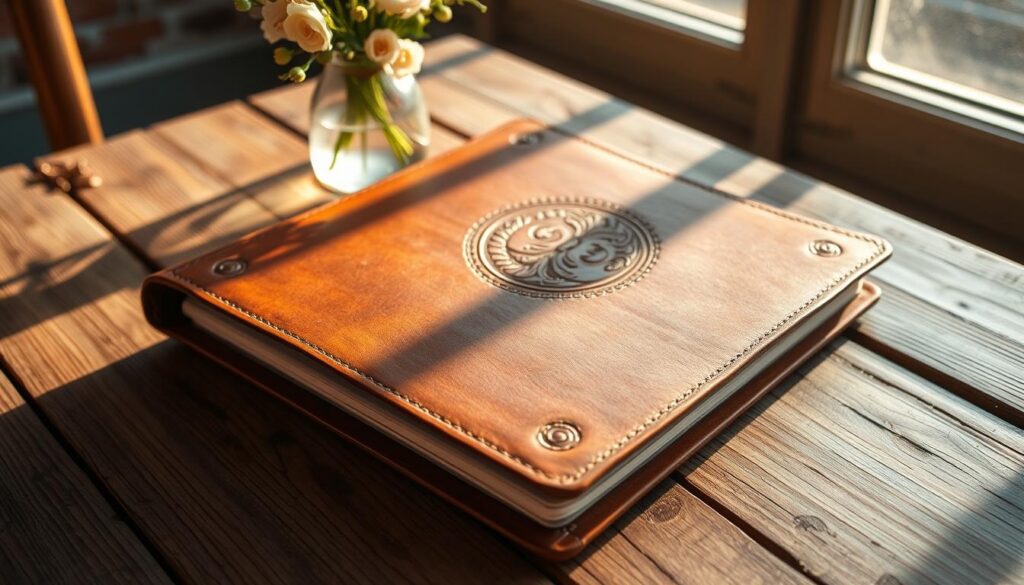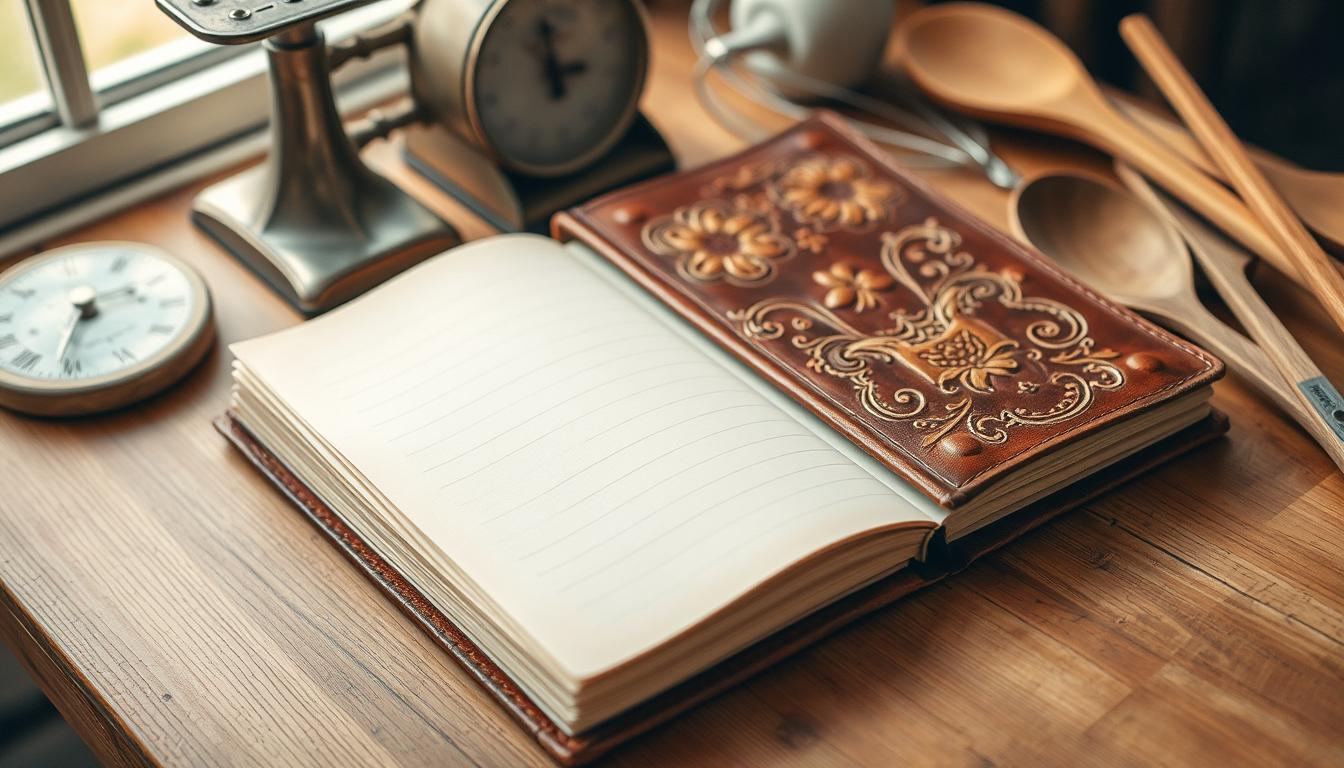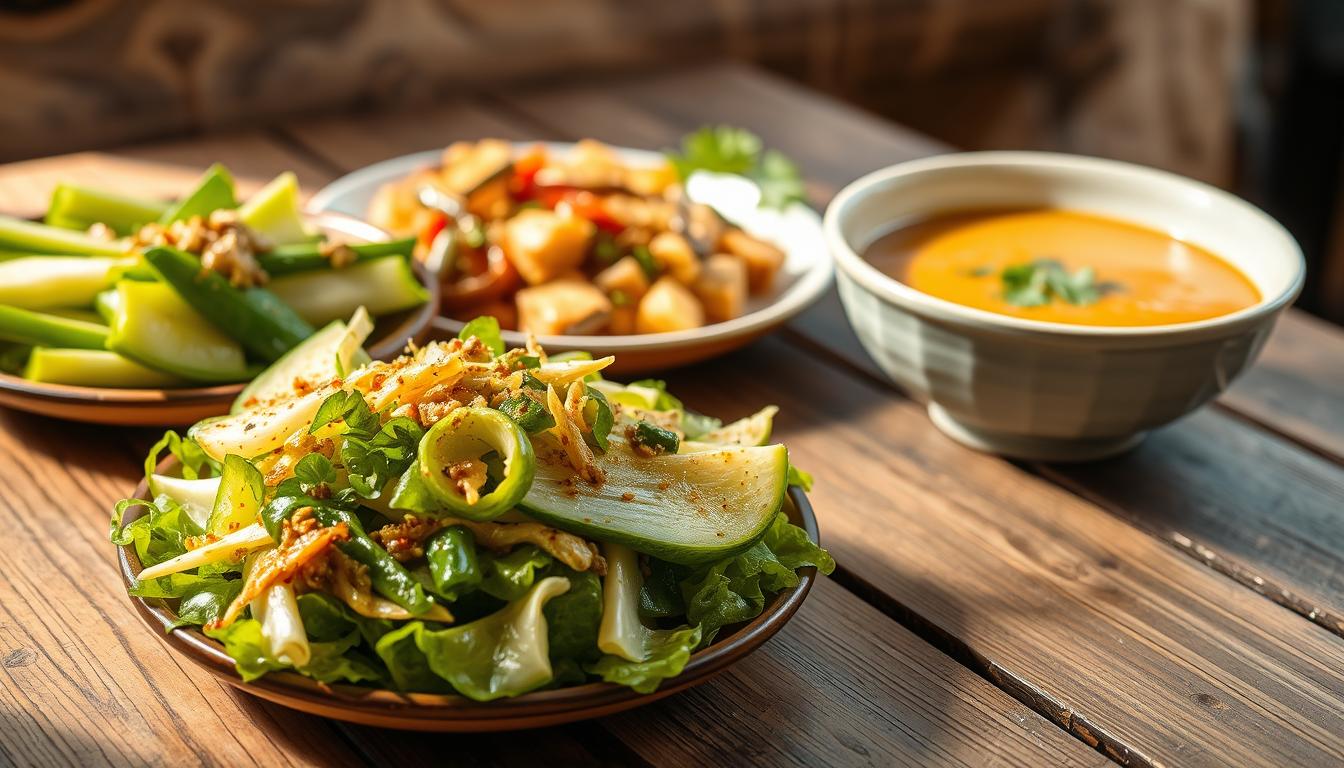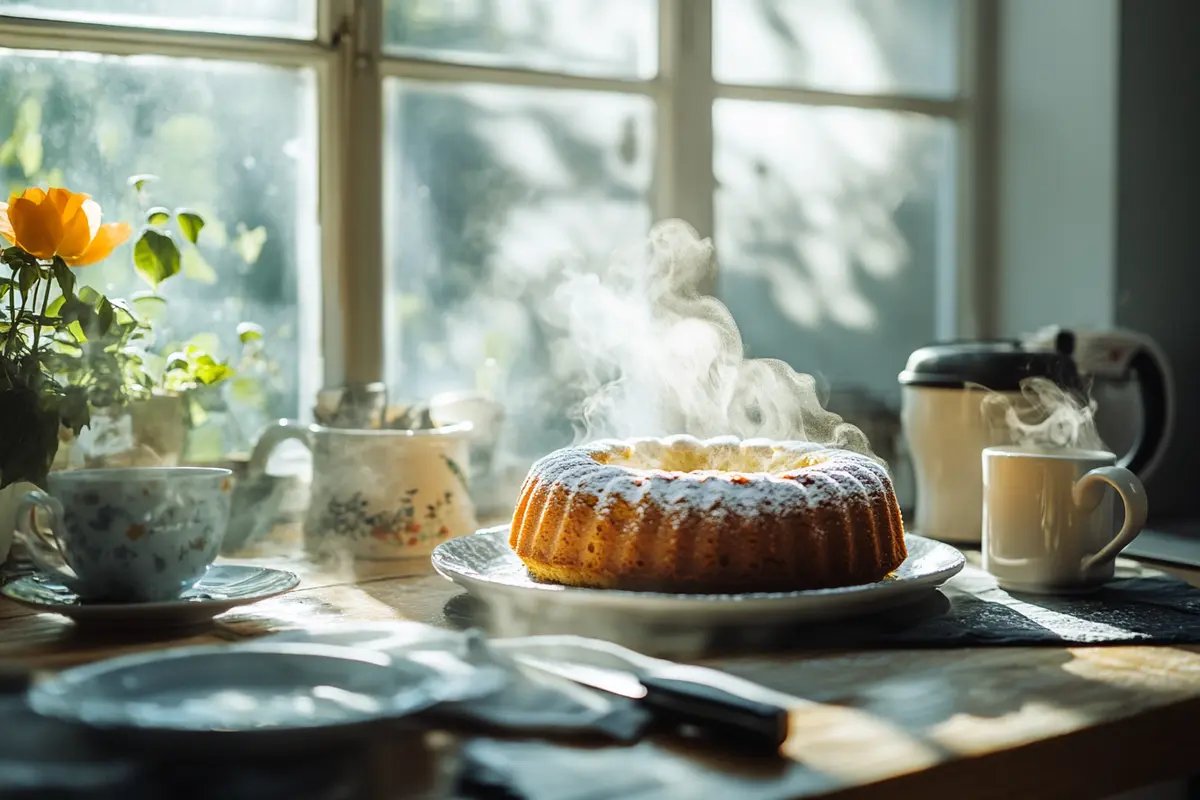In every family kitchen, there are hidden treasures. Recipes scribbled on the backs of envelopes, faded index cards tucked into drawers, and half-remembered dishes passed down from generation to generation.
These are more than just instructions for meals. They’re the flavors of your childhood, the aroma of holidays, and the stories told around the dinner table. Creating a culinary notebook lets you preserve these family traditions. It makes them accessible for future generations.
By crafting your perfect blank recipe book, you can organize your favorite dishes. You can note your own culinary experiments. And you can keep your family’s heritage alive.
Key Takeaways
- Preserve family recipes and traditions
- Create a personalized culinary notebook
- Organize your favorite dishes and experiments
- Keep your family’s culinary heritage alive
- Make your recipes accessible for future generations
Introduction to Blank Recipe Books
A blank recipe book is more than a notebook. It’s a canvas for your culinary creativity. Here, you can write down your favorite recipes and note the dishes you’ve tried. It becomes a personalized cookbook that shows your taste and cooking style.
What is a Blank Recipe Book?
A blank recipe book, also known as a recipe journal or blank cookbook, is a notebook for recording recipes. It’s different from pre-printed cookbooks because you can write your recipes in your own words. You can also add notes, photos, or illustrations.
Benefits of Using a Blank Recipe Book
Using a blank recipe book lets you organize your recipes your way. You can sort them by course, ingredient, or cooking method. It’s also a great way to keep your family’s recipes together. This makes it easier to share them with future generations. Some benefits include:
- Personalization: Tailor the book to your cooking style and preferences.
- Flexibility: Organize recipes in a way that makes sense to you.
- Creativity: Include notes, photos, and illustrations to make your cookbook unique.
As you can see, a blank recipe book is more than a tool for storing recipes. It’s a way to preserve your culinary heritage and share it with others. By using a blank recipe book, you’re creating a personalized cookbook that reflects your culinary journey.
Choosing the Right Format
The first step in creating your ideal cooking planner is choosing a format that suits your needs.
When selecting a blank recipe book, you have several options to consider. The type of blank recipe book you choose can significantly impact your cooking experience.
Types of Blank Recipe Books Available
There are various types of blank recipe books available, catering to different tastes and preferences. Popular options include the Clever Fox Recipe Book, Erin Condren Blank Recipe Book, and Lamare Blank Recipe Book. Each of these offers unique features such as durability, layout, and personalization options.
Digital vs. Paper Options
You can choose between digital and paper formats for your kitchen workbook. A digital cooking planner offers flexibility and ease of editing, while a paper-based book provides a tactile experience and can be more personal.
Consider your preferences and cooking habits when deciding between these options. If you enjoy writing down your recipes by hand, a paper blank recipe book might be the best choice. On the other hand, if you prefer the convenience of editing and sharing your recipes digitally, a digital cooking planner could be more suitable.
Customizing Your Blank Recipe Book
To make your blank recipe book truly yours, add personal touches. Include photos of your dishes, stories behind certain recipes, or illustrations. This makes your cookbook unique.
Adding Personal Touches
Adding personal touches makes your recipe book special. You can include photos of your culinary creations, stories about family traditions, or illustrations of your favorite ingredients. These elements make your cookbook enjoyable and reflect your culinary identity.
The Importance of Organization
Organizing your recipes is key for a recipe organizer or meal prep journal. It helps you find and use your recipes easily. Divide your book into sections like appetizers, main courses, and desserts.
A well-organized cookbook saves time and reduces stress. Use tabs, color coding, or a table of contents to make your recipes easy to find.
Suggested Sections to Include
Think about the sections you’ll find most useful. Here are some ideas:
- A section for meal planning
- A section for grocery lists
- A section for notes or tips
- A section for family recipes
| Section | Description | Benefits |
|---|---|---|
| Meal Planning | Plan your meals for the week | Saves time, reduces food waste |
| Grocery Lists | Keep track of the ingredients you need | Ensures you have all necessary ingredients |
| Notes or Tips | Record your cooking notes and tips | Helps you improve your cooking skills |
Tips for Writing Recipes
A well-structured recipe is key to a great blank recipe book. When you write recipes, you’re saving culinary traditions and memories. Turn your blank recipe book into a food diary to show your cooking journey.
How to Structure Your Recipes
It’s important to structure your recipes clearly. Start with a list of ingredients and their amounts. Then, write step-by-step instructions. Add a section for notes or tips to make it personal and useful.
For example, you can use a format like this:
| Ingredient | Quantity |
|---|---|
| Flour | 2 cups |
| Sugar | 1 cup |
Common Ingredients and Measurements
Standardizing measurements is helpful when writing recipes. Use cups, tablespoons, and teaspoons for dry ingredients. Use milliliters or liters for liquids. This makes recipes easier to follow and scale.
“The art of cooking is not just about following a recipe; it’s about understanding the nuances of flavors and textures.”
Writing Recipe Notes and Tips
Adding notes and tips can make your recipes more valuable. Share your experiences, like substitutions or variations you’ve tried.
For example, you might note that a spice can be adjusted or a cooking technique improves the dish.
Organization Strategies for Your Cookbook
To make the most of your blank recipe book, use smart organization strategies. A well-organized recipe journal or culinary notebook makes finding recipes easier. This boosts your cooking fun.
Organize your cookbook by categories and themes. Group similar recipes together, like desserts or main courses. This way, you can quickly find what you need.
Using Categories and Themes
Grouping recipes by theme makes your cookbook easier to use. You can have sections for holidays, family favorites, or cuisines. This helps you find recipes fast and try new ones.
Julia Child once said, “The only time to eat diet food is while you’re waiting for the steak to cook.” This shows the value of having many recipes, thanks to good categorization.
“The discovery of a new dish does more for human happiness than the discovery of a new star.” – Jean Anthelme Brillat-Savarin
Indexing for Quick Reference
An index in your recipe journal is a great idea. It lets you find recipes fast without flipping through the whole book. Just list the recipe names and their page numbers.
| Recipe Name | Page Number |
|---|---|
| Classic Lasagna | 12 |
| Chicken Parmesan | 15 |
| Vegetable Stir Fry | 28 |
Utilizing Color Coding or Tabs
Color coding or tabs can also help organize your culinary notebook. Use different colors or tabs for categories. This makes navigating your cookbook easier.
For example, use a red tab for desserts and a green tab for vegetarian dishes. This visual system helps you quickly find what you need.
By using these strategies, you can turn your blank recipe book into a useful recipe journal. It will make cooking more enjoyable.
Incorporating Family Traditions
Your blank cookbook is more than just a collection of recipes. It’s a chance to preserve family heritage. By adding family traditions, you make your cooking planner a personal reflection of your culinary journey.
Making a Heritage Recipe Section
Dedicating a section to heritage recipes is a great way to honor your family’s culinary history. This includes traditional dishes passed down through generations or recipes with special cultural significance.
- Identify key family recipes that are worth preserving.
- Organize these recipes into a cohesive section within your blank cookbook.
- Consider including historical context or stories behind each recipe.
Documenting Stories Behind Recipes
Documenting the stories behind your recipes adds depth and meaning to your blank cookbook. This includes memories associated with certain dishes, the origins of recipes, or the people who taught you to cook.
“The kitchen is a sacred space where stories are cooked along with the food.” – Unknown
By including these stories, you make your cooking planner a rich and engaging culinary history. It can be cherished by your family for years to come.

Designing an Attractive Layout
Your kitchen workbook’s layout is key to enjoying your favorite recipes. A good layout makes your recipe organizer look great and work better.
Think about how your blank recipe book will look and work. Pick the right fonts and colors. Try out different page layouts to see what you like best.
Choosing the Right Fonts and Colors
Fonts and colors greatly affect your kitchen workbook’s look and ease of use. Choose fonts that are easy to read, like Arial or Calibri. For colors, pick a few that look good together but aren’t too much.
Think about how colors make you feel. Green can make you think of fresh, healthy food. Orange and red can make you hungry.
Page Layout Ideas
Each page in your recipe organizer should be easy to read and follow. Here are some ideas:
- Have a special spot for each recipe, with room for name, ingredients, and instructions.
- Try a grid layout to keep things organized and clear.
- Don’t forget to leave some empty space to avoid too much clutter.
| Layout Element | Description | Benefits |
|---|---|---|
| Grid Layout | A structured layout that organizes content into rows and columns. | Enhances readability and makes recipes easy to follow. |
| Dedicated Recipe Sections | Separate sections for each recipe, including ingredients and instructions. | Improves organization and makes it easier to find specific recipes. |
| White Space | Areas of the page left empty to avoid clutter. | Reduces visual overwhelm and enhances the overall aesthetic. |
By picking the right fonts and colors, and trying out different layouts, you can make a kitchen workbook that’s both useful and pretty.
Securing Your Recipes
Your blank recipe book is full of delicious recipes. It’s important to keep it safe from loss or damage. This way, you can enjoy your favorite dishes for a long time.
There are two main steps to secure your recipes. First, back them up digitally. Second, protect the physical book from harm. Both steps will help you enjoy your cooking for years.
Options for Recipe Backup
One great way to keep your recipes safe is to make a digital copy. You can scan or take photos of your book’s pages. Save them on your computer or in the cloud. This way, your recipes are safe even if your book gets lost or damaged.
Another option is to type out your recipes. Save them in a digital meal prep journal. This not only keeps a backup but also makes sharing and editing recipes easy.
| Backup Method | Description | Benefits |
|---|---|---|
| Scanning/Photographing | Digitize your blank recipe book pages | Preserves original layout, easy to share |
| Digital Meal Prep Journal | Type out recipes and save digitally | Easily editable, accessible across devices |
Protecting Recipes from Spills and Damage
It’s also important to protect your blank recipe book from physical damage. Use a cover or sleeve to keep it safe from spills and stains.
Tips for Protection:
- Use a waterproof cover or sleeve
- Keep your book away from direct sunlight and moisture
- Handle your book with clean, dry hands
By following these steps, your blank recipe book will stay safe and useful for many years.
Sharing Your Blank Recipe Book
Once your blank recipe book is full of your favorite dishes, it’s time to share it. Yourrecipe journalis more than a personal cookbook. It’s a collection of family traditions and culinary experiences. Sharing it with loved ones can create a lasting legacy of your cooking journey.
Gifting Your Cookbooks
Giving your blank recipe book as a gift is a thoughtful act. You can make it personal by filling it with your recipes and stories. Add a special message or dedication to make it even more unique. For example, you could write,
“This cookbook is a collection of our family’s favorite recipes, passed down through generations. I hope you enjoy cooking and sharing these dishes as much as we have.”
Here’s a simple table to help you decide who to gift your cookbook to:
| Recipient | Occasion | Personal Touch |
|---|---|---|
| Family Member | Holiday or Birthday | Include family stories and history |
| Close Friend | Housewarming or Special Gathering | Add a personal message or inside joke |
Hosting Recipe Swap Events
Another way to share yourfood diaryis by hosting a recipe swap event. Invite friends and family to bring their favorite recipes. Share them with the group and have fun cooking and tasting different dishes. Consider a theme or specific cuisine to make it more interesting.

By sharing your blank recipe book, you spread the joy of cooking. You also create a sense of community and connection. So, don’t be shy – share your culinary creations and make some unforgettable memories!
Inspiration for Your Recipe Book
To keep your culinary notebook exciting, find inspiration from many places. A blank cookbook is perfect for trying out recipes from around the world. Always look for new flavors and ideas to keep it fresh.
“The discovery of a new dish does more for human happiness than the discovery of a new star,” said Jean Anthelme Brillat-Savarin. This quote shows the joy of discovering new recipes.
Sources of Culinary Ideas
There are many places to find culinary ideas. Check out cookbooks by famous chefs, food blogs, and social media. Traveling and trying local foods can also spark inspiration, as they often tell a region’s story.
- Cookbooks from celebrated chefs
- Food blogs and social media
- Culinary travel experiences
- Cooking classes or workshops
Cooking Show and Blog Recommendations
For cooking show and blog inspiration, here are some suggestions. “Salt, Fat, Acid, Heat” on Netflix explores what makes a dish special. “The Pioneer Woman” by Ree Drummond offers both comfort food and new ideas.
Other great choices include “Binging with Babish,” which links cooking to pop culture. And “Smitten Kitchen,” known for its creative, easy-to-make recipes. These can enrich your blank cookbook and show your culinary journey.
Maintaining Your Blank Recipe Book
Keeping your kitchen workbook up to date can really improve your cooking. A well-kept cooking planner keeps your recipes organized. It also becomes a special keepsake of your cooking journey.
To keep your blank recipe book in top shape, focus on regular updates and keeping it tidy. These steps will make your cookbook a valuable and fun resource.
Regular Updates and Revisions
It’s important to update your recipe book often. This lets you add new recipes you’ve tried and liked. You can also tweak existing ones based on your experiences. And, you can remove recipes that didn’t work out.
When you revise, follow these steps:
- Check your recipes regularly to see if they need changes.
- Add new recipes that you’ve enjoyed and want to make again.
- Remove or archive recipes you no longer use or that didn’t turn out well.
How to Keep it Neat and Tidy
Keeping your kitchen workbook neat is important for both looks and use. A tidy book is easier to use and enjoy. Here are some tips to keep it in good shape:
| Tip | Description |
|---|---|
| Use protective covers | Protect your cookbook from spills and wear by using covers or a protective sleeve. |
| Handle with care | Be gentle when handling your cookbook to prevent damage to the pages or binding. |
| Store properly | Keep your cookbook in a dry, cool place away from direct sunlight. |
By following these tips, your blank recipe book will stay a treasured part of your cooking journey. It will continue to inspire and guide you for many years.
Conclusion: Your Culinary Journey Awaits
As you finish reading this guide, you’re now ready to start your blank recipe book. This project is more than just collecting recipes. It’s about creating a special keepsake that shows your cooking journey.
Start Organizing Your Recipes
Begin by setting up your recipe organizer. It could be a digital tool or a beautifully designed paper book. Use it to organize your favorite dishes. This makes meal planning and tracking your cooking experiments easier.
Make Meal Planning a Breeze
As you fill your blank recipe book with your favorite recipes, meal planning gets easier. Consider using a meal prep journal to plan your weekly meals. This makes grocery shopping and cooking more efficient.
With your blank recipe book, you’re not just collecting recipes. You’re building a personal cookbook that tells your culinary story. So, get started and enjoy the journey of creating a unique and personalized recipe book.
FAQ
What is a blank recipe book, and how can it be used?
A blank recipe book is a cookbook with blank pages. You can write down your favorite recipes, notes, and cooking tips. It’s great for organizing your recipes, keeping family traditions alive, and creating a personal culinary journal.
What are the benefits of using a blank recipe book?
Using a blank recipe book lets you customize your cookbook. You can include your favorite recipes, notes, and photos. It becomes a unique and personal culinary resource.
What format options are available for blank recipe books?
You can choose between digital or paper blank recipe books. Digital options are flexible and easy to edit. Paper books offer a hands-on experience and can be a keepsake.
How do I choose the right blank recipe book for my needs?
When picking a blank recipe book, think about durability, personalization, and organization. Consider the type of recipes you’ll include, the space you need, and any special features you want.
How can I customize my blank recipe book?
To customize your blank recipe book, add personal touches. Include photos, create a table of contents, and organize your recipes in a way that makes sense to you. You can also add notes, tips, and stories behind the recipes.
What are some tips for writing recipes in a blank recipe book?
When writing recipes, include clear instructions and common ingredients and measurements. Add any relevant notes or tips. Use a standard format to make your recipes easy to follow.
How can I organize my blank recipe book?
You can organize your blank recipe book by categorizing recipes or creating an index. Use visual organization techniques like color coding or tabs. Find what works best for you.
Can I include family traditions and stories in my blank recipe book?
Yes, adding family traditions and stories makes your blank recipe book special. Create a heritage recipe section or document the stories behind your favorite recipes.
How can I protect my recipes from damage or loss?
To protect your recipes, make digital backups or store your blank recipe book safely. Use protective covers or pages to prevent damage from spills or wear and tear.
Can I share my blank recipe book with others?
Yes, you can share your blank recipe book by gifting it or using it for recipe swap events. You can also share your recipes digitally or create copies for friends and family.
How can I keep my blank recipe book up to date and organized?
Regularly update your blank recipe book by adding new recipes and revising existing ones. Keep it tidy. Set aside time to review and maintain your cookbook to keep it valuable.
Where can I find inspiration for new recipes to include in my blank recipe book?
Find inspiration for new recipes by following cooking shows, blogs, and social media. Experiment with new ingredients, cooking techniques, and cuisines to add variety to your cookbook.




